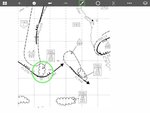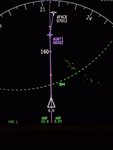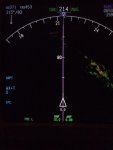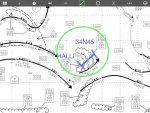Rusty Dave
#staffproto
With the recent Air Asia accident, I've had a few requests asking about how we deal with thunderstorms as airline pilots. Sorry it took so long but I wanted to put something together somewhat comprehensive.
I'd like to mention a couple of things before I talk about my perspective on Thunderstorms. First of all, I'm not in any way implying that the events of the Air Asia are related to anything I'm referring to. Until the facts come out, speculation will be left to the media. I wouldn't put too much faith into what the media has to say. Most of the time they are so far off in their speculation that it's almost comical. Most of what I'm referring to with regards to accidents involving thunderstorms are from Air France 447. I'm also a Boeing driver not an Airbus pilot. I know some of the systems logic is different with Boeing and Airbus. Perhaps an Airbus guy can add to the discussion. You can google the accident of Air France 447. There is plenty of info on the web about that tragedy.
Second, I'll give you a brief outline of what I do so you don't think I'm blowing smoke out of my a##. I'm an airline captain for a major airline in Canada. I have over 12000 hours total time and I've been a Captain here for over 11 years. Most of the winter I do Hawaii runs over the pacific. In the summertime, I try to stick to domestic/transborder or Caribbean flying. In other words, I'm constantly flying around the threat of thunderstorms. Whether it's over the non radar environment over the pacific or the 65000 foot monsters over Florida, I'm familiar with thunderstorms and understand the potential danger involved with them.
As with anything in aviation, everything we do is about threat and error management. Thunderstorms are no different. They are a potential threat that we manage. If we encounter a thunderstorm through an error (whether we entered it inadvertently or from air traffic control), we manage the error to provide a safe outcome. People make mistakes, airline pilots make mistakes. The key is to manage those mistakes properly. More about that later.
Ok. Let's talk thunderstorms. The first key is avoidance. We have many tools at our disposal. The first step starts at the flight planning level. Our dispatchers have access to software that allows them to make a decision about our routing. If it looks like there may be a problem area, they will flight plan us around the area. That makes our life much easier. Normally, we receive extra fuel to deviate around any potential thunderstorm activity. We are constantly monitoring our fuel so ensure we an have adequate amount to get to our destination plus a reserve level. Our dispatchers also keep us updated as to any potential weather problems ahead. We generally can only use our weather radar up to 200 miles ahead, so it helps when they are able to give us reports about weather hundreds of miles ahead of us. Our dispatcher may change our route to avoid weather 800 miles ahead.
Another valuable resource we have is air traffic control (ATC). The ATC guys in the states are awesome. They have an advanced radar that helps them reroute traffic around potential hazardous weather. This helps in and around high density airports. On many occasions I've left Toronto bound for Cuba or another Caribbean spot, only to have ATC give us a reroute to keep us clear of weather. This helps us and helps ATC, as it's easier to reroute airplanes early rather than having hundreds of airplanes asking for weather deviations on their own in a tight and dense airspace.
The other resource we have is our weather radar. This alerts us to upcoming hazardous weather. The weather radar paints precipitation rates ahead. The weather radar is a vital tool for us. It's my best friend. It's a key tool to mitigate the potential threats of serious weather ahead. Whether it's nighttime over the pacific, or I'm in cloud over Florida on a hot summers day, we use the radar to safely navigate around these thunderstorms. I can tell how high the thunderstorms are and how big they are. I can tell how intense they are. Different colours mean different levels of intensity. The green generally means light precip rate. I can expect light turbulence and icing but safely navigate through it. The yellow means a moderate level of precip. I can expect moderate turbulence and icing. I steer clear of yellow. Yellow can quickly turn to red. Red means heavy precip with moderate to severe turbulence and icing. This is what will hurt you. I will do everything in my power to avoid red. We have what is called "Captains emergency authority". It's basically the fact that if I feel the airplane is in danger I can do anything I need to escape that situation. It's the last line of defence. I've never had to exercise that power yet.
So when we are painting weather ahead on the radar, we can act accordingly. Sometimes we can safely fly above a thunderstorm. I've seen thunderstorms that peak at 28000 feet and I've seen ones that peak over 60000 feet. Anything in cruise above 30000 feet gets my attention. If I plan to fly over them I need to have a safe distance between us. A general rule is for every 10 knots of wind I like to clear the top of the storm by 1000 feet. So if there is 80kts of wind, I feel comfortable flying over the storm by 8000 feet. If storms are reaching 35000 feet, I would need to get up to 43000 feet. Being that the max we can get to is 41000 feet (most of the time is lower because we are too heavy to climb), flying over the storm is not an option. Therefore we must deviate around it. A general rule is to give it a 20 mile buffer at our cruise altitude. In descent, we again use the weather radar to navigate around them. We do this by asking ATC for deviations left or right of course depending on which way we want to go. I remember one particular flight. It was a redeye from Calgary to Halifax. We had to deviate 300 miles north of course to avoid a line of nasty thunderstorms over Quebec.
We can also look at the current winds to help with that decision. The upwind side of the thunderstorm is generally calmer than the downwind side as the downwind side airflow will have been disturbed by the convective cumulonimbus cloud or thunderstorm.
We can also use pilot reports to help our decision. If we are painting some green on the radar and a crew ahead of us reported moderate turbulence, we have the chance to change our plan accordingly.
We basically use all the tools available to us to mitigate the threat of the thunderstorm by avoiding the storm all together. It's the least amount of stress for us and keeps you folks happy and oblivious to the hard work we are doing up there to keep it smooth and safe.
Here is an example of proper planning:
On our flight from Vancouver to Kona, dispatch let us know about potential thunderstorm activity being forecast closer to the islands. This is the forecast chart. I've circled the potential area.

So we were ready for the potential weather. As we approached the islands, the weather started to appear on our radar.


The weather was below us and off to the right. There was no need to deviate.
The weather never was a factor.
On the flight from Kona to Vancouver last night we were advised by dispatch of potential weather about 90 minutes into the flight. Here is the chart and I've circled the forecasted weather.

We did have to deviate 20 miles left of course. Here is our nav display.

So, as you can see, with the proper planning, avoiding hazardous weather is not that big of a deal.
Now sometimes you encounter hazardous weather even though you've done everything to avoid it. The key here is to again use everything at your disposal to safely manage the situation.
At higher altitudes, the risks associated with thunderstorms are heavy. Knowing those risks and how the airplane might react is crucial. Air France 447 was a classic example. They inadvertently flew into the thunderstorm and the icing was so intense that the instrumentation gave them erroneous readings because the pitot tubes and static ports became blocked. Eventually they had an aerodynamic stall and because of the confusion caused by the erroneous readings of the instruments (primarily the airspeed), they kept pulling back on the control stick as opposed to pushing the nose over to gain airspeed and recover from the stall. As they continued to pull back on the stick, they further reduced their airspeed, got into a further deeper stall and lost all forward motion. From there they dropped about 35000 feet in 3 minutes. The sad thing is that we have independent instrumentation systems on modern commercial aircraft. One system for the captains side, one for the first officer side and one standby system. The flying pilot on the Air France accident had the erroneous readings while the other pilot had good readings. Had they recognized this, the accident could have been avoided. If you Wikipedia this event, it's quite fascinating. It's a series of mistakes that led to the tragedy. Break the chain of any of those mistakes and you have no accident.
At the end of the day, it's all about recognition and recovery. A stall is a stall. Recover accordingly.
Now sometimes you have to work in close proximity to thunderstorms. Take, climb out, approach and landing are examples. Fortunately, airport and aircraft equipment have come a long way to aid in detection of possible threats from the weather.
The threat from thunderstorms when we are operating at lower levels is windshear. Microbursts created by severe downdrafts create rapid change of wind speed and direction. Jet engines require "spool up" time. Power is not instantaneous. Therefore a sudden airspeed loss created by a microburst could cause potential problems. Modern airliner designers have factored this in by increasing idle thrust in case you need an increase of thrust due to an airspeed loss. This lessens the spool up time of the engine to give you your desired thrust settings and deal with the windshear.
Modern airliners also have advanced windshear detection with the radar. So if the radar detects windshear up ahead it will alert the pilots as to the location of the windshear. At that point, if on approach, we will conduct a go around to avoid the problem.
Most large airports also have windshear detection systems that will enable them to alert pilots of potential windshear threats. Usually when a thunderstorm is overhead an airport, ATC will start holding aircraft in racetrack circuits at several fixes outside the airport. When the weather clears aircraft will continue in for a safe approach and landing.
I can't remember the last time I've heard about a commercial airline accident due to windshear. Detection and prevention are excellent.
We also train in the simulators to deal with windshear, low energy awareness and stall recognition and recovery. We also train in unreliable instrumentation recognition. If anything, we are over trained so that if we ever encounter any of these situations, we can deal with it in a safe and timely manner.
So, I guess I'll wrap up by saying that thunderstorms are one of the many potential threats we deal with in commercial flying. As with anything is all about managing the situation. I hope this helps a bit. Feel free to ask me any questions.
Cheers
Sent from my iPad using Tapatalk
I'd like to mention a couple of things before I talk about my perspective on Thunderstorms. First of all, I'm not in any way implying that the events of the Air Asia are related to anything I'm referring to. Until the facts come out, speculation will be left to the media. I wouldn't put too much faith into what the media has to say. Most of the time they are so far off in their speculation that it's almost comical. Most of what I'm referring to with regards to accidents involving thunderstorms are from Air France 447. I'm also a Boeing driver not an Airbus pilot. I know some of the systems logic is different with Boeing and Airbus. Perhaps an Airbus guy can add to the discussion. You can google the accident of Air France 447. There is plenty of info on the web about that tragedy.
Second, I'll give you a brief outline of what I do so you don't think I'm blowing smoke out of my a##. I'm an airline captain for a major airline in Canada. I have over 12000 hours total time and I've been a Captain here for over 11 years. Most of the winter I do Hawaii runs over the pacific. In the summertime, I try to stick to domestic/transborder or Caribbean flying. In other words, I'm constantly flying around the threat of thunderstorms. Whether it's over the non radar environment over the pacific or the 65000 foot monsters over Florida, I'm familiar with thunderstorms and understand the potential danger involved with them.
As with anything in aviation, everything we do is about threat and error management. Thunderstorms are no different. They are a potential threat that we manage. If we encounter a thunderstorm through an error (whether we entered it inadvertently or from air traffic control), we manage the error to provide a safe outcome. People make mistakes, airline pilots make mistakes. The key is to manage those mistakes properly. More about that later.
Ok. Let's talk thunderstorms. The first key is avoidance. We have many tools at our disposal. The first step starts at the flight planning level. Our dispatchers have access to software that allows them to make a decision about our routing. If it looks like there may be a problem area, they will flight plan us around the area. That makes our life much easier. Normally, we receive extra fuel to deviate around any potential thunderstorm activity. We are constantly monitoring our fuel so ensure we an have adequate amount to get to our destination plus a reserve level. Our dispatchers also keep us updated as to any potential weather problems ahead. We generally can only use our weather radar up to 200 miles ahead, so it helps when they are able to give us reports about weather hundreds of miles ahead of us. Our dispatcher may change our route to avoid weather 800 miles ahead.
Another valuable resource we have is air traffic control (ATC). The ATC guys in the states are awesome. They have an advanced radar that helps them reroute traffic around potential hazardous weather. This helps in and around high density airports. On many occasions I've left Toronto bound for Cuba or another Caribbean spot, only to have ATC give us a reroute to keep us clear of weather. This helps us and helps ATC, as it's easier to reroute airplanes early rather than having hundreds of airplanes asking for weather deviations on their own in a tight and dense airspace.
The other resource we have is our weather radar. This alerts us to upcoming hazardous weather. The weather radar paints precipitation rates ahead. The weather radar is a vital tool for us. It's my best friend. It's a key tool to mitigate the potential threats of serious weather ahead. Whether it's nighttime over the pacific, or I'm in cloud over Florida on a hot summers day, we use the radar to safely navigate around these thunderstorms. I can tell how high the thunderstorms are and how big they are. I can tell how intense they are. Different colours mean different levels of intensity. The green generally means light precip rate. I can expect light turbulence and icing but safely navigate through it. The yellow means a moderate level of precip. I can expect moderate turbulence and icing. I steer clear of yellow. Yellow can quickly turn to red. Red means heavy precip with moderate to severe turbulence and icing. This is what will hurt you. I will do everything in my power to avoid red. We have what is called "Captains emergency authority". It's basically the fact that if I feel the airplane is in danger I can do anything I need to escape that situation. It's the last line of defence. I've never had to exercise that power yet.
So when we are painting weather ahead on the radar, we can act accordingly. Sometimes we can safely fly above a thunderstorm. I've seen thunderstorms that peak at 28000 feet and I've seen ones that peak over 60000 feet. Anything in cruise above 30000 feet gets my attention. If I plan to fly over them I need to have a safe distance between us. A general rule is for every 10 knots of wind I like to clear the top of the storm by 1000 feet. So if there is 80kts of wind, I feel comfortable flying over the storm by 8000 feet. If storms are reaching 35000 feet, I would need to get up to 43000 feet. Being that the max we can get to is 41000 feet (most of the time is lower because we are too heavy to climb), flying over the storm is not an option. Therefore we must deviate around it. A general rule is to give it a 20 mile buffer at our cruise altitude. In descent, we again use the weather radar to navigate around them. We do this by asking ATC for deviations left or right of course depending on which way we want to go. I remember one particular flight. It was a redeye from Calgary to Halifax. We had to deviate 300 miles north of course to avoid a line of nasty thunderstorms over Quebec.
We can also look at the current winds to help with that decision. The upwind side of the thunderstorm is generally calmer than the downwind side as the downwind side airflow will have been disturbed by the convective cumulonimbus cloud or thunderstorm.
We can also use pilot reports to help our decision. If we are painting some green on the radar and a crew ahead of us reported moderate turbulence, we have the chance to change our plan accordingly.
We basically use all the tools available to us to mitigate the threat of the thunderstorm by avoiding the storm all together. It's the least amount of stress for us and keeps you folks happy and oblivious to the hard work we are doing up there to keep it smooth and safe.
Here is an example of proper planning:
On our flight from Vancouver to Kona, dispatch let us know about potential thunderstorm activity being forecast closer to the islands. This is the forecast chart. I've circled the potential area.

So we were ready for the potential weather. As we approached the islands, the weather started to appear on our radar.


The weather was below us and off to the right. There was no need to deviate.
The weather never was a factor.
On the flight from Kona to Vancouver last night we were advised by dispatch of potential weather about 90 minutes into the flight. Here is the chart and I've circled the forecasted weather.

We did have to deviate 20 miles left of course. Here is our nav display.

So, as you can see, with the proper planning, avoiding hazardous weather is not that big of a deal.
Now sometimes you encounter hazardous weather even though you've done everything to avoid it. The key here is to again use everything at your disposal to safely manage the situation.
At higher altitudes, the risks associated with thunderstorms are heavy. Knowing those risks and how the airplane might react is crucial. Air France 447 was a classic example. They inadvertently flew into the thunderstorm and the icing was so intense that the instrumentation gave them erroneous readings because the pitot tubes and static ports became blocked. Eventually they had an aerodynamic stall and because of the confusion caused by the erroneous readings of the instruments (primarily the airspeed), they kept pulling back on the control stick as opposed to pushing the nose over to gain airspeed and recover from the stall. As they continued to pull back on the stick, they further reduced their airspeed, got into a further deeper stall and lost all forward motion. From there they dropped about 35000 feet in 3 minutes. The sad thing is that we have independent instrumentation systems on modern commercial aircraft. One system for the captains side, one for the first officer side and one standby system. The flying pilot on the Air France accident had the erroneous readings while the other pilot had good readings. Had they recognized this, the accident could have been avoided. If you Wikipedia this event, it's quite fascinating. It's a series of mistakes that led to the tragedy. Break the chain of any of those mistakes and you have no accident.
At the end of the day, it's all about recognition and recovery. A stall is a stall. Recover accordingly.
Now sometimes you have to work in close proximity to thunderstorms. Take, climb out, approach and landing are examples. Fortunately, airport and aircraft equipment have come a long way to aid in detection of possible threats from the weather.
The threat from thunderstorms when we are operating at lower levels is windshear. Microbursts created by severe downdrafts create rapid change of wind speed and direction. Jet engines require "spool up" time. Power is not instantaneous. Therefore a sudden airspeed loss created by a microburst could cause potential problems. Modern airliner designers have factored this in by increasing idle thrust in case you need an increase of thrust due to an airspeed loss. This lessens the spool up time of the engine to give you your desired thrust settings and deal with the windshear.
Modern airliners also have advanced windshear detection with the radar. So if the radar detects windshear up ahead it will alert the pilots as to the location of the windshear. At that point, if on approach, we will conduct a go around to avoid the problem.
Most large airports also have windshear detection systems that will enable them to alert pilots of potential windshear threats. Usually when a thunderstorm is overhead an airport, ATC will start holding aircraft in racetrack circuits at several fixes outside the airport. When the weather clears aircraft will continue in for a safe approach and landing.
I can't remember the last time I've heard about a commercial airline accident due to windshear. Detection and prevention are excellent.
We also train in the simulators to deal with windshear, low energy awareness and stall recognition and recovery. We also train in unreliable instrumentation recognition. If anything, we are over trained so that if we ever encounter any of these situations, we can deal with it in a safe and timely manner.
So, I guess I'll wrap up by saying that thunderstorms are one of the many potential threats we deal with in commercial flying. As with anything is all about managing the situation. I hope this helps a bit. Feel free to ask me any questions.
Cheers
Sent from my iPad using Tapatalk
Last edited:






